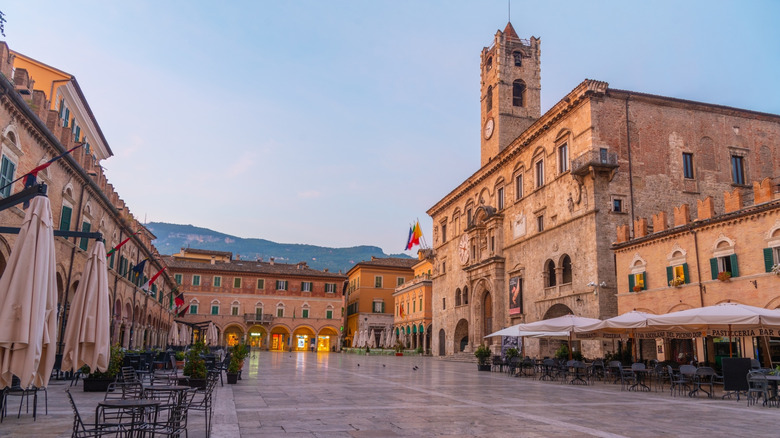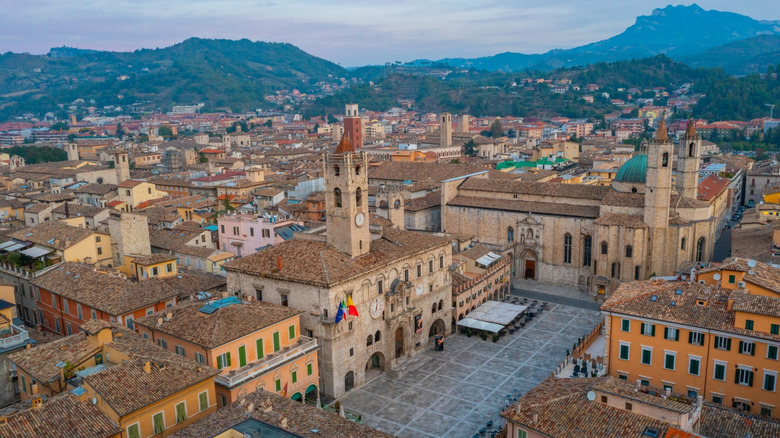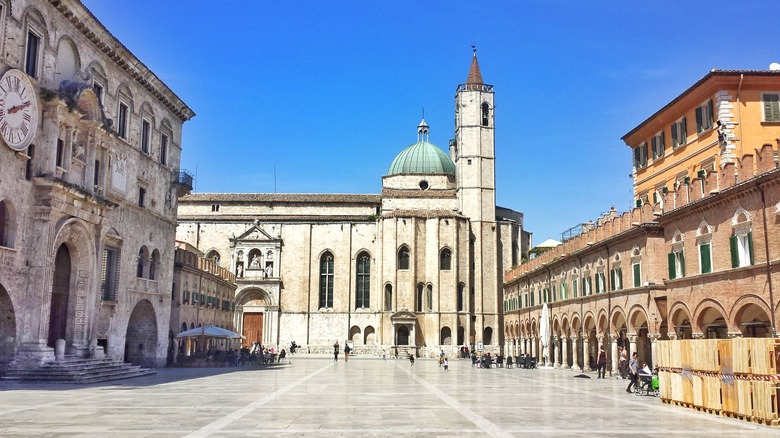Italy's Precious Stone Mountain Town Called 'A Miniature Ancient Rome' Literally Glows At Night
A far cry from one of Italy's most overrated tourist traps exists a glowing town in Le Marche, a lesser-known spot that travelers will find as a respite from the hustle and bustle of visiting an enormous metropolitan city. While there are many awe-inspiring destinations in Rome, Ascoli Piceno spares travelers to Italy the dense throngs of tourists common in the Eternal City and offers a glimpse of stunning Roman architecture in a small, mountainside town. Located near central Italy's east coast along the Adriatic Sea, Ascoli Piceno is about a 30-minute drive from the shore in the Le Marche region of Italy. Nestled between rivers, mountains, and national parks, Ascoli Piceno is about a 2-and-a-half-hour drive northeast of Rome and is in a region known for a wealth of travertine stone deposits.
Travertine, a type of limestone, is coveted in the home decor and renovation industries, making it an expensive material. Travertine is formed naturally near hot springs rich in minerals like calcium carbonate, which seep into the surrounding stone to lend color and subtle patterns to the stone. Most travertine comes from the central Italian region of Lazio, where Rome and rock quarries in Tivoli are located, but it can also be found in Valle del Tronto, which is in close proximity to Ascoli Piceno. Not only is the town of Ascoli Piceno constructed largely from this beautiful, pale stone, but many famous monuments in Rome were also made from travertine, like the Colosseum and the Trevi Fountain.
Ascoli Piceno was built from the same material as many highlights in Rome
Ascoli Piceno has often been compared to ancient Rome, and for good reason. Once the Romans conquered Ascoli in the 3rd century B.C., they noticed that the surrounding areas had deposits of travertine similar to the land outside of Rome, and then began to construct Romanesque buildings in Ascoli Piceno in the glimmering travertine stone. They sought to recreate the Eternal City in a location near the opposite coast, complete with temples, a capitol building, and spas. The town's second square, the Piazza San Tommaso, has curved edges rather than straight angles because it is located on the grounds of an ancient Roman amphitheater.
In Ascoli Piceno, the travertine stone boasts a neutral color palette with subtle tones like pale cream, warm honey, and even flecks of darker, rusty browns alongside shades of white, gray, and beige. The Piazza del Popolo is a shining gem of the city, made entirely of smooth, polished travertine, and it is said to be one of Italy's most stunning piazzas, or central town squares, and dates back to the 1500s. Travertine, which appears similar to marble in the way that it shines and reflects light, has the ability to seemingly absorb and echo sources of illumination. The buildings, columns, and floors shine pale and bright while the sun is out, slowly changing to a warm, pink-orange hue to mirror the sunset, and then later glows once the sun has set, reflecting the moonlight and any surrounding building lights.
Take time to savor the sights in Ascoli Piceno
Life is a bit slower in the small town, where you can sip an espresso at your own pace while reading a book or enjoy an aperitivo peacefully in a piazza and bask in the glow of the travertine stones, but don't expect a quick dinner anywhere during your time in Italy. In the Piazza del Popolo, only the famed Caffè Meletti's Art Nouveau architecture breaks up the travertine surfaces of the rest of the piazza. The namesake of the Anisetta Meletti Amaro, Caffè Meletti began as a distillery for the amaro but is now a bustling cafe that's popular any time of day with tourists and locals, serving morning espressos and pastries to evening snacks and cocktails for aperitivo.
There are regular markets and antique fairs held in the Piazza del Popolo on the third Sunday of every month, and the town delicacy not to be missed is sold from carts in the piazza: the Ascolana olive. These large green olives are stuffed with meat, cheese, and spices before being coated in bread crumbs and deep-fried. Carnevale of Ascoli Piceno is similar to Mardi Gras or Fat Tuesday celebrations in the United States, as it culminates on Shrove Tuesday, the day before the beginning of Lent. Large, elaborate, chandelier-like lanterns are strung up in the Piazza del Popolo, illuminating the reflective stone that shines on the piazza floor. No matter the season, the stunning, radiant town is beautiful to visit any time of year.


